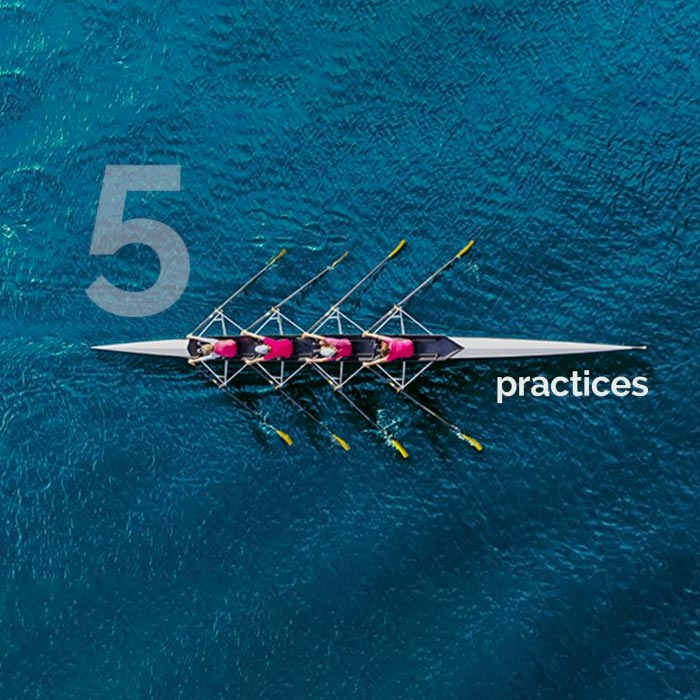We are almost a month into the New Year and it feels like yesterday that I was sitting around the Thanksgiving table with my family, reflecting on what a crazy, unprecedented and challenging year 2020 had been. And as the month of January flies by, I am honestly not confident that 2021 will be quick to promise change.
But one thing is certain. Now is the time to link arms and step together as fundraisers and ministry partners into the potentially difficult months ahead. Today, I want to provide you with 5 encouraging tips on how your organization can boldly face challenges and become an even stronger team in 2021.
Benjamin Disraeli, a 19th century British politician and thought leader regarding world affairs, once said, “There is no education like adversity.” Another great thought leader of our own century and man of faith, Billy Graham, is credited with the saying, “Comfort and prosperity have never enriched the world as much as adversity has.”
I believe it, and I have seen it in the last year. Our clients have demonstrated tremendous resourcefulness, flexibility, devotion… expending themselves for the love of those they serve. Our team at BDI has become more agile and has demonstrated even greater determination and creative ingenuity with respect to our client work. And donors have really stepped up to give sacrificially and generously – across the board, increasing overall revenue YOY 22%-67% and online total revenue as much as 129% YOY.
In 2020, for me and my team, two words have really defined our race plan as we have collectively navigated these challenges – resilience and agility.
- Resilience refers to the process of managing and adapting while forging strength and ultimately, prospering in the face of adversity. Literally, it’s derived from a Latin word for “bouncing back,” yet it also implies landing in a far more positive place – colloquially, making lemonade when life gives you lemons. Resilience refers to the “recovery” phase.
- Agility, on the other hand, speaks to the ability to move or shift direction swiftly – 2020’s buzzword “pivot” – requiring strength, dexterity, insight, discernment, precision and timeliness.
Back in my college days, I was a competitive rower, and now, I’m blessed/cursed to see rowing metaphors in virtually every challenging endeavor I face. As a rower, a number of things are a given. Before you set the shell in the water, you must have the fitness, the skill, the mental readiness, the right talent in the right seats and optimal equipment – calibrated and in order. All of which are transferable concepts for business in the real world. This is exactly how we all function successfully in our respective professional capacities.

The rowing analogy for 2020 is choppy water, swells, cross winds, gusting headwinds, freezing temperatures, loose rigging, blistered hands, taking an oar to the ribcage, etc. You get the idea. A rowing shell has no keel, so conditions like these will throw off the balance and potentially flip the boat entirely. A crew must rely on temperament, teamwork, trust, technique and tenacity to navigate waters such as these.
Alas, 2021 will usher in more of the same. As fundraisers, how should we approach the ongoing challenge? We now know the drill, yes. And yet, we don’t know whether current trends in generosity will continue. Will donor giving remain as strong as it was in Year One? And might we face new challenges? We approach 2021 as prepared as we can be.
Here are a few thoughts, imbued with rowing analogies:
Temperament
When facing rough water, the number one best practice is to keep calm. Self-control is critical. Emotional intelligence must meet muster. Light hands on the oars will provide stability during each stroke. Work with the water. To be calm in the face of adversity requires assessing and understanding what you can control – judiciously. Check your riggings, your processes, your partnerships, your assessment tools, your data points, your results, and evaluate them in light of the heavy chop.
“Supplement your… knowledge with self-control, and self-control with steadfastness…”
(2 Peter 1:6, ESV)
Teamwork
One of the most important moments of a rowing stroke is dropping the oar into the water at precisely the same time as all the others in the boat – ideally, at the same angle, quickness of hand, and depth and then driving through the stroke at the same speed, exiting from the water at the exact same moment, feathering the oar together and then traveling up the slide to the next “catch” in sync with everyone else in the boat. If one person feathers late, the wind will catch that oar and throw off the balance and direction of the craft.
This is a picture of communication. Establish a seamless MO for communication on your team. Think fluency. Create a race plan that defines how your organization will operate into Year Two of this new environment. Ensure everyone is on board.
Establishing the plan will provide stable conditions for agile and effective problem solving as well as traction. What you’re looking for is that magical moment in the middle of a race called “the swing” – something only achieved when everyone in the boat is “rowing in such perfect unison that no single action by any one rower is out of sync with those of all the others… Only then will the boat continue to run, unchecked, fluidly and gracefully between the pulls of the oars” (Boys in the Boat, 2013, Daniel James Brown). It’s the integrated harmony, the sum of many parts, talented, impassioned people, honoring one another and together making steady forward progress.
Trust
When you are 250 meters into the race and University of Washington, Princeton and Navy are all making a push to get ahead, you look… and you fret. The very minute you look, you not only lose momentum – but you also potentially throw off the whole boat. Keep your attentional focus on your work at hand. Trust your teammates to do the same. Information is vital, but keep your eyes and heads in the boat and trust your leadership for the critical internal and external intel. Trust them to exercise strategic agility in the face of change. And… fret not.
One of my most anticipated races was always the annual Head of the Charles in Boston. It is the largest 2-day regatta in the world, with 11,000 athletes, rowing in over 1,900 boats, on a 3-mile course, on the bendy and blustery Charles River, with no fewer than 7 bridges. For spectators it is a picnic, literally. For those in the boat, it’s a wonderfully brutal obstacle course. Countless shells race to skinny through narrow bridge arches and manage sweeping curves. Without absolute trust in your teammates, submitting one to one another (Ephesians 5:21), you’re likely to get hurt, hurt others, break oars or entirely destroy the boat.
Technique
You have got to be good at what you do! In an environment of uncertainty, things are changing all the time. Your organization depends on you doing your job to the best of your ability. Master your talent, practice diligence, hone your skills, seek training as needed and most of all, be prepared to pivot (there’s that word again!). Credibility in your professional life is a function of your skillset, your dependability and your output.
I sat in the 6-seat in my boat throughout college – the first seat in the “engine room” – setting up the length of the stroke and the speed of the leg drive for the rest of the boat and transmitting the rhythm to the bow. That was where I belonged! It met my skill set (long legs primarily!), and it was where I needed to sit for the good of the team. Embrace your place and optimize your craft.
“Whatever you do, work at it with all your heart…”
(Colossians 3:23, NIV)
Tenacity
Navigating rough water is not for the faint of heart. Navigating a charitable organization through uncertain times requires a can-do attitude, sound strategy, hard work, patience, endurance, surrender (but not giving up) and transformational leadership – no matter which seat you’re sitting in. It’s gutsy, giving and inspiring leadership that extends trust to you to grow and give shape to the success of the organization. It’s a mindset and a question of culture.
Here’s where I get to brag about BDI: Transformational leadership is our DNA. And it allows us to care for our clients in unique, dynamic, sharp, effective, agile and resilient ways.
So let’s welcome 2021 like I remember welcoming each race day when I was rowing – with a healthy mix of excitement, anticipation, spirit, grit and yes, even a little dread. But no worries! You’ve got this, and if you already partner with BDI, we’ve got this together.
You need to read this! Click here to read “Leading the Charge in 2021” from BDI’s CEO and President, Michael J. Tomlinson.





